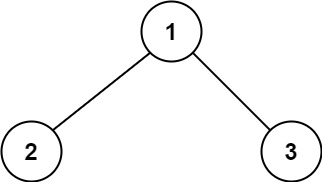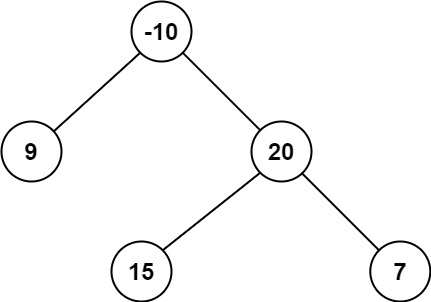LeetCode-in-All
124. Binary Tree Maximum Path Sum
Hard
A path in a binary tree is a sequence of nodes where each pair of adjacent nodes in the sequence has an edge connecting them. A node can only appear in the sequence at most once. Note that the path does not need to pass through the root.
The path sum of a path is the sum of the node’s values in the path.
Given the root of a binary tree, return the maximum path sum of any non-empty path.
Example 1:

Input: root = [1,2,3]
Output: 6
Explanation: The optimal path is 2 -> 1 -> 3 with a path sum of 2 + 1 + 3 = 6.
Example 2:

Input: root = [-10,9,20,null,null,15,7]
Output: 42
Explanation: The optimal path is 15 -> 20 -> 7 with a path sum of 15 + 20 + 7 = 42.
Constraints:
- The number of nodes in the tree is in the range
[1, 3 * 104]. -1000 <= Node.val <= 1000
To solve the “Binary Tree Maximum Path Sum” problem in Python with a Solution class, we’ll use a recursive approach. Below are the steps:
-
Create a
Solutionclass: Define a class namedSolutionto encapsulate our solution methods. -
Create a
maxPathSummethod: This method takes the root node of the binary tree as input and returns the maximum path sum. - Define a recursive helper method: Define a recursive helper method
maxSumPathto compute the maximum path sum rooted at the current node.- The method should return the maximum path sum that can be obtained from the current node to any of its descendants.
- We’ll use a post-order traversal to traverse the tree.
- For each node:
- Compute the maximum path sum for the left and right subtrees recursively.
- Update the maximum path sum by considering three cases:
- The current node itself.
- The current node plus the maximum path sum of the left subtree.
- The current node plus the maximum path sum of the right subtree.
- Update the global maximum path sum if necessary by considering the sum of the current node, left subtree, and right subtree.
-
Initialize a variable to store the maximum path sum: Initialize a global variable
maxSumto store the maximum path sum. -
Call the helper method: Call the
maxSumPathmethod with the root node. - Return the maximum path sum: After traversing the entire tree, return the
maxSum.
Here’s the Python implementation:
class Solution:
def __init__(self):
self.max_sum = float('-inf')
def maxPathSum(self, root: TreeNode) -> int:
self.helper(root)
return self.max_sum
def helper(self, root):
if not root:
return 0
left = max(0, self.helper(root.left))
right = max(0, self.helper(root.right))
current = root.val + left + right
self.max_sum = max(self.max_sum, current)
return root.val + max(left, right)
This implementation follows the steps outlined above and efficiently computes the maximum path sum in a binary tree in Python.

